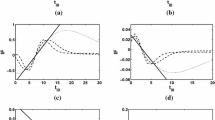Abstract
Generalized linear and nonlinear mixed-effects models are used extensively in biomedical, social, and agricultural sciences. The statistical analysis of these models is based on the asymptotic properties of the maximum likelihood estimator. However, it is usually assumed that the maximum likelihood estimator is consistent, without providing a proof. A rigorous proof of the consistency by verifying conditions from existing results can be very difficult due to the integrated likelihood. In this paper, we present some easily verifiable conditions for the strong consistency of the maximum likelihood estimator in generalized linear and nonlinear mixed-effects models. Based on this result, we prove that the maximum likelihood estimator is consistent for some frequently used models such as mixed-effects logistic regression models and growth curve models.
Similar content being viewed by others
References
Anderson DA, Aitkin M (1985) Variance component models with binary response: Interviewer variability. J Roy Stat Soc B 47:203–210
Andrews DWK (1987) Consistency in nonlinear econometric models: a generic uniform law of large numbers. Econometrica 55:1465–1471
Booth JG, Hobert JP (1999) Maximizing generalized linear mixed model likelihoods with an automated Monte Carlo EM algorithm. J Roy Stat Soc B Methodol 61:265–285
Bradley RA, Gart JJ (1962) The asymptotic properties of ML estimators when sampling from associated populations. Biometrika 49(1–2):205–214
Breslow NE, Clayton DG (1993) Approximate inference in generalized linear mixed models. J Am Stat Assoc 88(421):9–25
Bulter SM, Louis TA (1997) Consistency of maximum likelihood estimators in general random effects models for binary data. Ann Stat 25:351–377
Choirat C, Hess C, Seri R (2003) A functional version of the birkhoff ergodic theorem for a normal integrand: a variational approach. Ann Prob 31:63–92
Chung KL (1968) A course in probability theory. Harcourt Brace & World, USA
Cramer H (1946) Mathematical methods of statistics. Princeton University Press, Princeton
Davidian M, Giltinan DM (1993) Some general estimation methods for nonlinear mixed-effects models. J Biopharm Stat 3(1):23–55
Davidian M, Giltinan DM (1995) Nonlinear models for repeated measurements data. Chapman and Hall, London
Diggle PJ, Heagetty P, Liang K-Y, Zeger SL (2002) Analysis of longitudinal data. Oxford University Press, Oxford
Dupacova J, Wets R (1988) Asymptotic behaviour of statistical estimators and of optimal solutions of stochastic optimization problems. Ann Stat 16:1517–1549
Hedeker D, Gibbons RD (1994) A random-effects ordinal regression model for multilevel analysis. Biometrics 50:933–944
Hoadley B (1971) Asymptotic properties of maximum likelihood estimators for the independent not identically distributed case. Ann Math Stat 42(6):1977–1991
Jiang J (1999) Conditional inference about generalized linear mixed models. Ann Stat 27:1974–2007
Lehmann EL (1983) Theory of point estimation. John Wiley, New York
Liang K-Y, Zeger SL (1986) Longitudinal data analysis using generalized linear models. Biometrika 73:13–22
Lindstrom MJ, Bates DM (1990) Nonlinear mixed effects models for repeated measures data. Biometrics 46:673–687
McCulloch CE (1997) Maximum likelihood algorithms for generalized linear mixed models. J Am Stat Assoc 92:162–170
McCulloch CE (2003) Generalized linear mixed models. vol. 7 of CBMS/IMS monograph series
Mentré F, Gomeli R (1995) A two-step iterative algorithm for estimation in nonlinear mixed-effect models with an evaluation in population pharmacokinetics. J Biopharm Stat 5(2):141–158
Pinheiro JC, Bates DM (1995) Approximation to the log-likelihood function in the nonlinear mixed-effects models. J Comput Graph Stat 4:12–35
Potscher DM, Prucha IR (1989) A uniform law of large numbers fo dependent and heterogeneous data processes. Econometrica 57:675–683
Roe DJ (1997) Comparison of population pharmacokienetic modeling methods using simulated data: Results from the population modeling workgroup. Stat Med 16:1241–1262
Sheiner LB, Beal SL (1980) Evaluation of method for estimating population pharmacokinetic parameters, I. Michaelis-Menten model: routine clinical pharmacokienetic data. J Pharmacokienet Biopharm 8:553–571
Stiratelli R, Laird N, Ware J (1984) Random effects models for serial observations with binary responses. Biometrics 40:961–971
Tutz G, Fahrmeir L (2001) Multivariate statistical modelling based on generalized linear models. Springer, Berlin Heidelberg New Tork
Vonesh EF, Chinchilli VM (1997) Linear and nonlinear models for the analysis of repeated measurements. Marcel Dekker, New York
Vonesh EF, Wang H, Nie L, Majumdar D (2002) Conditional second-order generalized estimating equations for generalized linear and nonlinear mixed-effects models. J Am Stat Assoc 96:282–291
Wald A (1949) Note on the consistency of the maximum likelihood estimate. Ann Math Stat 20:595–601
Wolfinger RD, Lin X (1997) Two Taylor-series approximation methods for nonlinear mixed models. Comput Stat Data Anal 25:465–490
Zeger SL, Karim MR (1991) Generalized linear models with random effects: a Gibbs sampling approach. J Am Stat Assoc 86:79–86
Author information
Authors and Affiliations
Corresponding author
Rights and permissions
About this article
Cite this article
Nie, L. Strong Consistency of the Maximum Likelihood Estimator in Generalized Linear and Nonlinear Mixed-Effects Models. Metrika 63, 123–143 (2006). https://doi.org/10.1007/s00184-005-0001-3
Received:
Published:
Issue Date:
DOI: https://doi.org/10.1007/s00184-005-0001-3
Keywords
- Maximum likelihood estimator
- Generalized linear mixed-effects models
- Nonlinear mixed-effects models
- Random effects
- Strong consistency



